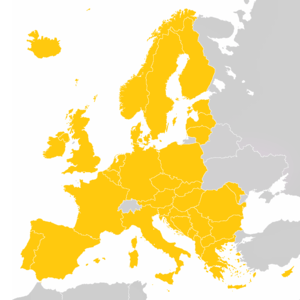Single European Sky
The Single European Sky is a European Commission initiative that seeks to reform the European air traffic management system through a series of actions carried out in four different levels (institutional, operational, technological and control and supervision) with the aim of satisfying the needs of the European airspace in terms of capacity, safety, efficiency and environmental impact.[1]

This is hoped to benefit airspace users by ensuring the safe and efficient utilisation of airspace and the air traffic management system within and beyond the EU. Airspace management is planned to move away from the current domination by national borders to the use of 'functional airspace blocks' the boundaries of which will be designed to maximise the efficiency of the airspace. Within the airspace, air traffic management, while continuing to have safety as its primary objective, will also be driven by the requirements of the airspace user and the need to provide for increasing air traffic. The aim is to use air traffic management that is more closely based on desired flight patterns leading to greater safety, efficiency and capacity.
Air traffic management in the European Union is undertaken by member countries, co-operating through EUROCONTROL, an intergovernmental organisation that includes most of the European countries.
European air spaces are some of the busiest in the world, and the current system of air traffic management allegedly suffers from several parameters, such as using national borders in the sky, and having large areas of airspace reserved for national military use when in fact they may not be needed.
History
In October 2001, the European Commission adopted proposals for a Single European Sky, to create a Union regulator for air traffic management within the countries forming the European Union, Norway and Switzerland. The European Union regulator was supposed to merge upper European airspaces, currently divided into national zones. It was proposed to organise this airspace uniformly, with air traffic control areas based on operational efficiency, instead of national borders. Also, there were plans to integrate civil and military air traffic management.
There are discussions about enlarging the initiative to cover the Balkan and Mediterranean countries.
In June 2008, a revision of the SES regulations was adopted, called SES-II. Focus is here on four areas:
- The existing Single Sky legislation is sharpened to deal with performance and environmental challenges.
- The Single European Sky ATM Research (SESAR) programme is to provide the future technology.
- The competence of the European Aviation Safety Agency (EASA) is to be extended to aerodromes, air traffic management and air navigation services.
- The 'action plan for airport capacity, efficiency and safety' is to be implemented thus providing ground capacity.
The SES-II aims at implementing FABs as a mean for providing better performance.
On 10 June 2013, the European Commission presented its plan "B" to speed up the implementation process of SES. The so-called SES 2+ is a package of measure which aim at challenging the current situation with state owned monopolies responsible for providing air navigation services. At the same time, transport workers' union ETF announced mobilising its members to protest against the suggested package.[2][3]
As of 2019, nothing about the plan has been officially realized.
Exclusion
One report from the British Parliament, dated 2000, reported that Spain blocked the inclusion of Gibraltar Airport in the Single European Sky, meaning the whole package was suspended.[4]
Dates
- November 2000: establishment of the SES regulation.
- June 2008: SES-II regulation adopted.
Acceleration
The air travel disruption after the 2010 Eyjafjallajökull eruption may have caused a purported acceleration to push the national air traffic control systems to collaborate into the Single European Sky, and the immediate creation of a crisis co-ordination group to handle future transport disruptions.[5]
See also
- Air travel disruption after the 2010 Eyjafjallajökull eruption
- European Common Aviation Area
- Eurocontrol
- European Neighbourhood Policy
- Single European Sky ATM Research (SESAR)
- South-East Europe Regional Energy Market
- Stability Pact for South Eastern Europe
Notes
- (GARCÍA FERREIRO, Anxo. «El Cielo Único Europeo. Un nuevo concepto de gestión del tráfico aéreo para Europa», en Curso de Derecho Aeronáutico Práctico para Operadores Aéreos. Instituto Iberoamericano de Derecho Aeronáutico y del Espacio y de la Aviación Comercial. Madrid 2016, p. 243)
- "The sky has a limit". www.eurocockpit.be. 5 November 2012.
- "Unions mobilise to further halt European reform". Air Traffic Management. 9 June 2013.
- "Foreign Affairs Committee Report". www.parliament.co.uk.
- NYtimes.com
References
- (es) GARCÍA FERREIRO, Anxo. «The Single European Sky. A new concept of air traffic management for Europe»: Curso de Derecho Aeronáutico Práctico para Operadores Aéreos. Instituto Iberoamericano de Derecho Aeronáutico y del Espacio y de la Aviación Comercial. Madrid |2016
- Single European Sky (SES)
- The European ATM Master plan
External links
- Single European Sky – European Commission website
- Single European Sky – EUROCONTROL website
- Single European Sky – Performance Scheme Indicator meta-data
- Airports Council International EUROPE website
- Construction of the Single European Sky
- Implementing Rules for the Single European Sky
- Multilateral Agreement on the establishment of a European Common Aviation Area
- The Commission launches Single European Sky II for safer, greener and more punctual flying
- Clean Sky